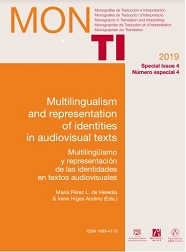Prisoner Identities: Representation, Stereotype and Intersectionality in the Translation of the Latina Woman in Orange Is the New Black
Main Article Content
Abstract
Downloads
Article Details
The documents contained in these directories are included by the contributing authors as a means to ensure timely dissemination of scholarly and technical work on a non-commercial basis. It is understood that all persons copying this information will adhere to the terms and constraints invoked by each author's copyright. These works may not be reposted without the explicit permission of the copyright holder.
References
Bhabha, Homi K. (1994) The Location of Culture. Londres & Nueva York: Routledge.
Brufau Alvira, Nuria. (2009) Traducción y género: propuestas para nuevas éticas de la traducción en la era del feminismo transnacional. Salamanca: Universidad de Salamanca. Tesis doctoral inédita.
Brufau Alvira, Nuria. (2010) “Interviewing Luise von Flotow. A New State of the Art.” Quaderns. Revista de traducció 17, pp. 283-292.
Bucholtz, Mary. (1995) “From Mulatta to Mestiza: Language and the Reshaping of Ethnic Identity.” En: Hall, Kira & Mary Bucholtz (eds.) (1995) Language and the Socially Constructed Self. Nueva York: Routledge, pp. 351-373.
Butler, Judith. (1990) Gender Trouble. Feminism and the Subversion of Identity. Londres & Nueva York: Routledge.
Castells, Manuel. (2008) “Comunicación, poder y contrapoder en la sociedad red (I). Los medios y la política.” Telos 74. pp. 13-24Versión electrónica: https://telos.fundaciontelefonica.com/telos/articuloautorinvitado.asp@idarticulo=1&rev=74. htm
Chambers, Samuel A. (2009) The Queer Politics of Television. Londres & Nueva York: I. B. Tauris.
Cronin, Michael. (2006) Translation and Identity. Londres & Nueva York:
Routledge.
De Higes-Andino, Irene et al. (2013) “Subtitling Language Diversity in Spanish Immigration Films.” Meta 58:1, pp. 134-145.
De Marco, Marcella. (2012) Audiovisual Translation through a Gender Lens. Ámsterdam & Nueva York: Rodopi.
Díaz-Cintas, Jorge. (2012a) “Presentation.” Meta 57:2, pp. 275-278.
Díaz-Cintas, Jorge. (2012b) “Clearing the Smoke to See the Screen: Ideological Manipulation in Audiovisual Translation.” Meta 57:2, pp. 279-293.
Díaz-Cintas, Jorge; Ilaria Parini & Irene Ranzato (eds.) (2016) Altre Modernità. Numero Speciale Ideological Manipulation in Audiovisual Translation.
Enck, Suzanne M. & Megan E. Morrissey. (2015) “If Orange Is the New Black, I Must Be Color Blind: Comic Framings of Post-Racism in the Prison-Industrial Complex.” Critical Studies in Media Communication 32:5, pp. 303-317.
Fina, Anna. (2007) “Code-switching and the Construction of Ethnic Identity in a Community of Practice.” Language in Society 36:3, pp. 371-392.
Gentzler, Edwin. (2012) “Translation without Borders.” En: Translation: A Transdisciplinary Journal. Versión electrónica: http://translation.fusp.it/articles/translation-without-borders
González-Iglesias, J. David & Fernando Toda. (2013) “Traducción y Conflicto: Perdidos en la traducción.” En: Vidal Claramonte, África & M. Rosario Martín Ruano (eds.) 2013. Traducción, política(s) y conflictos: legados y retos para la era del multiculturalismo. Granada: Comares, pp. 27-43.
Hall, Stuart. (1973) Encoding and Decoding in the Television Discourse. Birmingham: Centre for Cultural Studies, University of Birmingham.
Hall, Stuart. (1995) “The Whites of Their Eyes.” En: Dines, Gail & Jean M. Humez (eds.) 2003. Gender, Race, and Class in Media. A Text Reader. Londres & Nueva Delhi: Sage, pp. 89-93.
Hall, Stuart. (1996) “Who Needs Identity?” En: Hall, Stuart & Paul du Gay (eds.) 1996. Questions of Cultural Identity. Londres, Thousand Oaks & Nueva Delhi: Sage Publications, pp. 1-17.
Hall, Stuart. (2000) “The Question of Cultural Identity.” En: Hall, Stuart;
David Held; Don Hubert & Kenneth Thompson (eds.) 2000. Modernity: An Introduction to Modern Societies. Malden & Oxford: Blackwell, pp. 595-634.
House, Juliane; M. Rosario Martín Ruano & Nicole Baumgarten. (2005)
“Introduction.” En: House, Juliane; M. Rosario Martín Ruano & Nicole
Baumgarten (eds.) 2005. Translation and the Construction of Identity. Seúl: IATIS, pp. 3-13.
Martín Ruano, M. Rosario. (2016) “Traducción, medios de comunicación, opinión pública: los retos éticos de la construcción de la actualidad.” En: Martín Ruano, M. Rosario & África Vidal Claramonte (eds.) 2016. Traducción, medios de comunicación, opinión pública. Granada: Comares, pp. 1-14.
Martínez Pleguezuelos, Antonio Jesús. (2016) “Representación de la homosexualidad, identidad saliente y traducción: estudio del doblaje de Will & Grace en español.” En: Martín Ruano, M. Rosario & África Vidal Claramonte (eds.) 2016. Traducción, medios de comunicación y opinión pública. Granada: Comares, pp. 209-224.
Martínez-Sierra, Juan José et al. (2010) “Linguistic Diversity in Spanish
Immigration Films. A Translational Approach.” En: Berger, Verena & Miya Komori (eds.) 2010 Polyglot Cinema. Migration and Transcultural Narration in France, Italy, Portugal and Spain. Viena: LIT, pp. 15-28.
Mira, Alberto. (2012) “¿Gay, queer, gender…? Paradigmas críticos. El ejemplo de representación lésbica en las nuevas series.” En: Vera Rojas, María Teresa (ed.) 2012. Nuevas subjetividades/sexualidades literarias. Barcelona & Madrid: Egales, pp. 41-52.
Mulvey, Laura. (1975) “Visual Pleasure and Narrative Cinema.” En: Brandy, Leo & Marshall Cohen (eds.) 1999. Film Theory and Criticism: Introductory Readings. Nueva York: Oxford University Press, pp. 833-844.
Pérez L. de Heredia, María. (2015) “Traducción y globalización de estereotipos interseccionales en televisión: una imagen panorámica.” En: Penas Ibáñez, María Azucena (ed.) 2015. La traducción. Nuevos planteamientos teóricos-metodológicos. Madrid: Síntesis, pp. 261-282.
Pérez L. de Heredia, María. (2016a) “Reescritura divergente y traducción de estereotipos de género en televisión: el caso de Orange Is the New Black.” En: Martín Ruano, M. Rosario & África Vidal Claramonte (eds.) 2016. Traducción, medios de comunicación, opinión pública. Granada: Comares, pp. 193-208.
Pérez L. de Heredia, María. (2016b) “Translating Gender Stereotypes: An Overview on Global Telefiction.” En: Altre Modernità, número especial Ideological manipulation in Audiovisual Translation, pp. 166-181.
Rosenberg, Alyssa. (2015) “How ‘Orange Is the New Black’ Wins at Illustrating Identity.” En: The Washington Post. Versión electrónica: https://www.washingtonpost.com/news/in-theory/wp/2015/09/22/how-orange-is-the-newblack-wins-at-illustrating-identity/?utm_term=.c24098b1a31b
Shohat, Ella & Robert Stam. (2003) “Introduction.” En: Shoat, Ella & Robert Stam (eds.) 2003. Multiculturalism, Postcoloniality, and Transnational Media. New Brunswick, New Jersey & Londres: Rutgers University Press, pp. 1-17.
Valdivia, Angharad N. (2014) “Latina/os and the Media: a National Category with Transnational Implications.” Polifonia 21:29, pp. 13-27.
Vidal Claramonte, África. (2007) Traducir entre culturas: poderes, diferencias, identidades. Fráncfort del Meno: Peter Lang.
Vidal Claramonte, África. (2015) “Traducir al atravesado.” Papers 100:3, pp. 345-363.
Von Flotow, Luise. (2009) “Contested Gender in Translation: Intersectionality and Metramorphics.” Palimpsestes 22, pp. 245-256. Versión electrónica: http://palimpsestes.revues.org/211


